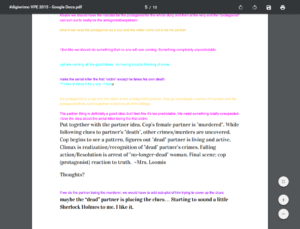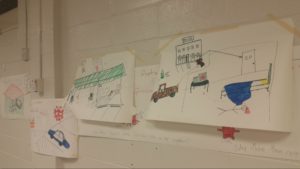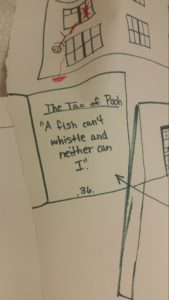It began with a blank Google Doc. No ideas, no suggestions, and no direction. Just a notion that somehow three small high school classes could use a digital space to create something together even though they were physically apart.
I was involved with digital and hybrid spaces as I worked through my Master of Education degree, but I never really saw it in action as a class project, especially at the high school level. As a teacher of more than 20 years, I wanted to do something fresh that would push students beyond traditional creative writing and group projects. It isn’t the first time I’ve experimented with unusual forms; I incorporated altered books into my English/Language Arts (ELA) classes in the mid 1990s, and I’ve written curriculum for two different classes blending ELA and photography. Extending my interest in online spaces to the classroom felt natural for me. Digital Writing Month (DigiWriMo) provided an opportunity for students to explore their own creativity by writing a short story in an online space where their audience might be other students they would likely never meet face to face. Their story, Whistling, turned into a learning experience that blended critical thinking and creativity.
Inspired by National Novel Writing Month (NaNoWriMo), DigiWriMo draws on the affordances of digital tools for creation and sharing. Remix has a home here, as does original work. It is an active Twitter space, as #DiGiWriMo connects participants to each other, becoming a place for sharing links to creations of every imaginable medium and responding to other participants in dialogues that are part professional, part personal, and all participatory.
Collaborative projects, like Whistling, connect to the participatory culture described by Henry Jenkins, Mizuko Ito, and danah boyd as user generated content in online spaces. Their most recent collaboration, Participatory Culture in a Networked Era, was published after the students completed Whistling, but the issues discussed by the authors are similar to things I encountered as student composed the story. Many students today move fluidly between digital and physical spaces, but not all. The idea that all American teens today are digital natives is simply not the case. However, as a group, teens often adapt more readily than many adults to the idea that the real and virtual can, and do, overlap. Jenkins notes that social media users tend to spend much of their interaction online in relationships that are also face to face. Projects like #digiwrimo may expand the notion that online spaces are open to the whole world, and that there is no reason to limit participation and connections to familiar practices.
Collaborative learning inhabits an essential space in a well rounded education because so much of post-school work is made up of group projects. Dewey’s discussion of continuity in Education and Experience rings as truly now as it was when he wrote it in 1938. Education is not just about subject matter or content areas — educative experiences prepare students for their future development and growth in both academic and practical matters. Individuals must know how to work with groups of people without shouldering the burden of the whole project. Teachers and students alike have seen that old nemesis: group work disintegrating into one worker, one loafer, and a few who fall somewhere between. Collaborative learning in schools increases enjoyment of learning which may increase attention and retention. Finding the balance of excellence and accountability constitutes a considerable challenge. #DigiWriMo offered a chance to take advantage of the benefits of group work with an accountability feature that helped spread the work around so that no one student felt the burden. The added incentive of knowing that other people within the #DigiWriMo space would read the final story encouraged a pursuit of excellence in storytelling instead of a good-enough-for-class product. The short time span of #DigiWriMo (less than three weeks because of Thanksgiving break in the US) also added to the urgency of the project so procrastinators did not have time to put off participation.
It’s important to know that the students who authored Whistling attended a hybrid school, which only met face to face once a week. Students were accustomed to working independently and at home, without a teacher in front to keep them on task. Additionally, the classes met at different hours during the one day on campus, so there was never an opportunity for everyone to be together in the same room. The hybrid nature of the school also demanded students take ownership and initiative with every part of the composition. They knew their participation was part of the graded work, but how they chose to participate was not dictated. Some students struggled with the notion that they really did have the freedom to create something without an authority figure telling them what was right or wrong. The lack of a rubric was discomforting to some who were accustomed to checklists in their independent study. Other students, particularly the ones who found traditional learning methods troublesome, latched onto the creative concept with great enthusiasm. Within a few days organic organization took root and students found their places in the process. This very Deweyan ideal of creating an experiential event led students to follow their curiosities into places that ultimately moved the story project forward. Some focused on research, some on story line, while others paid attention to logic, rationale, and consistency. Each student brought particular strengths to the project, and each provided an expertise that allowed them to participate in leadership roles. Dewey’s discussion of education being made up of productive experiences that consider the “powers and purposes” of students informs the power of this particular project and others like it.
The first order of business was to establish a working format. Using the blank Google Doc as a work space, students chose colors or fonts to distinguish themselves. This had the added benefit of letting me know who wrote what and allowed me to follow conversations between students as they worked through various elements. I had already introduced them to the basic elements of plot, so I set that up as a loose outline: Beginning Balance, Inciting Incident, Rising Course of Action, Climax, and Falling to Resolution. This gave students a place to organize their ideas.
The open, collaborative document proved essential, because students could access it whenever they had opportunity, whether on a computer or on a mobile device. Using different colors or fonts added a level of accountability for me to quickly assess participation and interaction. My ability to track participation acted to motivate some students and to offer an element of relief for others who might otherwise carry the burden of production in most group projects.
I used the comments feature of Google Docs to ask questions. The first question was genre: history? romance? drama? action? mystery? Students opted for a murder mystery, with half the students chiming in on the chat portion, while others limited their comments to the document itself without stating firm opinions. No one objected, so that was set. Then they decided on a first-person narrator, thinking it would be easier to write from that point of view. They learned as we went along that a limited and unreliable narrator may have been harder to produce with any sense of authenticity than an omniscient voice that knows all the answers and back stories. Since this was their project, first person it would be.

The comments section buzzed with ideas and then some brave souls started brainstorming on the document itself. Removing the traditional rules of the classroom and of the five-paragraph essay gave them a sense of freedom from the usual expectations of form and content that apply to schoolwork. They tossed around various scenarios without discounting any ideas, validating everyone’s thought processes. It was fun to watch an unimpeded brainstorm in progress. Watching and listening and reading gave me some insights into my students that I may have missed otherwise. The quieter students wrote more than I expected, and the students who seemed disinterested in class seemed to open up in this creative space. I didn’t have to tell any students to be respectful of ideas or their peers; students governed themselves in a surprisingly egalitarian way. It may have been the process of writing that afforded extra thought behind commenting because it required thinking about both what to say and how to say it. Conversations bounced around various scenarios until one student wrote, “The protagonist is a cop and the villain is the protagonist’s partner. They go investigate a series of murders and the protagonist finds out his partner is behind all the killings.” That set off a whole thread of ideas: the partner/villain is a woman, the partner/villain is the first victim, the villain is a serial killer motivated by revenge on a justice system gone wrong, and a dozen other permutations. I stood back so they could discuss, and the Google Doc became a rainbow of conversation.
This happened outside of class hours, with students logging in when they could, adding ideas, commenting on others, and writing possible details or clues. At the end of each day, I worked through the document, pulling together ideas, summarizing others, and asking questions about clarity, logic, and story structure.

The students in one face-to-face class took on the task of creating a paper storyboard to have a visual flow as they progressed. All the students had access to that room at different times during the week, so they could check progress, add images or questions, and use the visuals as they returned to the Google Doc. For as much as this generation has embraced the digital tools, we are still largely an analog culture. It’s easier to get lost in the details of a virtual world and sometimes only a return to an analog reality to see and remember the big picture. It’s akin to being so focused on a close reading character analysis that the reader forgets the arc of the story unless it touches that particular character. There is room in a digital pedagogy for analog activity; in fact, the hybridization of digital and analog creates a strong learning environment that allows individualization without losing a collaborative human experience.

The physical storyboard in the classroom served as a useful tool, inspiring new ideas as well as some important questions about how the clues and story would work.
Now and then, I added lines to the Google Doc in a large font so it was easy to see what the definite elements were, but as the document grew, my words diminished while the colorful student words increased. This indicated student ownership of the story and meant my task of helping with the structure was nearly done. The Whistling storyboard changed when ideas were scrapped and new ones emerged. A second Google Doc contained the story as it emerged without commentary or multiple voices.

Various students took special interest in a variety of elements on their own initiative. One researched Fugu poisoning as one of the murder weapons, while another took up quotes from the Tao of Pooh as a common thread. Still another looked up Rorschach tests and how evidence in investigations is handled. Others ensured dialogue was realistic and consistent throughout the story. Names of characters came from the face to face composition class. Drepa is an old Norse word for kill, so it made a good surname for our murderous police officer. Other names were random or spins of names belonging to people they knew. These are the kinds of details students should observe in both the literature they read and in the writing they do. Details make writing come alive and add to the believability of the piece, however fantastical it may be. That the students chose to do extra research without prompting indicated high engagement with the process.
The final workday happened in a Google Hangout. Students talked through the story trying to find a way to end with a punch. They knew the ending but struggled with how to express it. They tried a number of ideas, but abandoned them as too complex. Finally, one student working in the Google Doc added the final line. The rest of the group immediately agreed that it was simple, effective, and just a little creepy. They liked the idea that, while readers should know who the murderer was, the end was unresolved.

I cleaned up the draft and published Whistling to my blog (and the Twitterverse). Students loved seeing their names as contributing authors, and took special delight in reading tweets responding to their work.
As students reflected on the experience when it was over, most felt their voices were heard even in the chaos of the Google Doc. All students agreed that using the Google Doc as a common workspace was key to the success of the story, and that the storyboard in the classroom helped keep the story organized, even though many only had access once a week. The Hangouts were the least effective method of communication in the students’ minds, possibly partly because it was the first experience with Hangouts for many. The one surprising response was that every student mentioned a sense of camaraderie with their co-authors, particularly with those they didn’t already know well. The shared experience taught them that writing can be fun, the best ideas sometimes come from unexpected places, and group work can be both enjoyable and productive.
Publishing is another essential element. Knowing that their work would be read by people in the #digiwrimo community added an element of attention to detail that may not have been addressed in a story written for internal reading only. Students were more willing to compromise for the sake of the story and didn’t have to be reminded to proofread and revise where necessary. It was fun for me as a teacher watch the lessons I have taught in action. Hearing how others responded to the story after publication added to the thrill for both the students and for me. Suddenly, their writing mattered. It wasn’t about the grade or the class; it was about the story.
Being a small school made this digital writing project manageable, but larger classes could collaborate on their own stories in groups of 10–12. I recommend working across classes and grade levels so that students from different classes work together. For large groups, it may be best to have multiple projects, as more than 15–20 people on a document may be both confusing and allow some students to minimize their participation by choice or by default. This is an issue in most group projects whether in school or in business; there are some who prefer not to participate and others whose voices are silenced by louder ones. Working with other hybrid schools across the US (or internationally) might add an element of multicultural experience and create working relationships that mimic those in the business world.
Life is made up in stories. Some stories — like Whistling — are fiction, allowing imagination free rein, constrained only by a modicum of believability. Real-life stories have no such constraints, and so the stories of our lives have no boundaries. Our roles as educators should mirror real life, not fiction. Teachers ought to seek out ways to engage students by finding educative uses for both spaces, especially when those spaces can converge on a single project and then expand to share that experience with a broad audience. If we want authenticity from our students, we need to take authentic risks that allow student voices to prevail. This project could have been a complete disaster, but I know (and Dewey, Jenkins, Ito, boyd, and others back me up) that freedom from grades and expectations can unleash great creativity.

